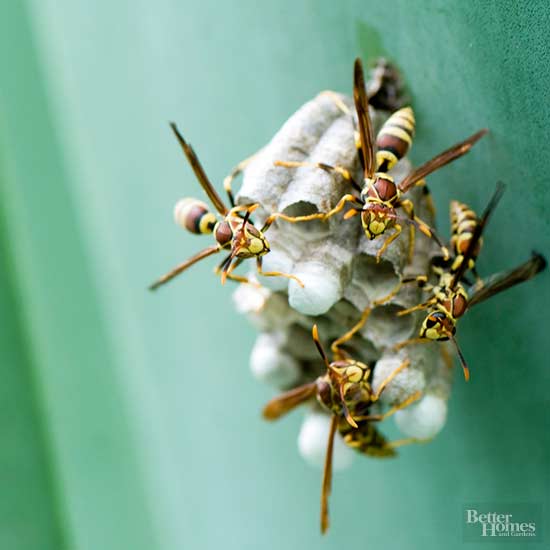






The word wasp is an umbrella term used for thousands of types of flying and stinging insects, including yellow jackets, hornets, and paper wasps. Unlike bees, which are needed to pollinate plants, most wasps are not pollinators. They can be very aggressive toward humans, injuring us with stings that can cause swelling and allergic reactions. Remember though that wasps are predators of other insects and shouldn't be destroyed without cause.
How can you tell if a flying insect is a beneficial bee or a threatening wasp? A wasp has a waist that is much thinner than the rest of its body; a bee's body is about the same thickness throughout.
Wasp bodies look almost sleek, lacking the fuzzy hairs that enable bees to gather pollen. Beware: Color isn't a reliable way to tell the difference between a bee and a wasp, although many wasps have a distinctive yellow-and-black striped pattern, and some hornets are black and white.
continue reading belowSome yellow jackets build their papery nests below ground in hollow logs or other cavities, while others build rounded hanging nests that resemble large paper coconuts.
Paper wasps build nests that look like umbrella-shaped honeycombs; they are often found under overhangs, beams, and limbs.
In both cases, leave the nests alone if they are in places you can avoid. Wasps only use a nest for one year, although they may return to a site if it's an especially good one.
If you find a wasp nest in early spring, when the colony is still small, you can try sealing up all openings to the nests. However, if wasps are nesting inside a house, such as inside the siding, never block the hole, as the wasps will find a way to get inside.
Knock out nests in the spring and early summer with a pressurized spray of water from a distance of at least 15 to 20 feet. Be prepared to run.
Wasp bait and traps work on some species, but only early in the season. Remove wasp traps before midsummer so they don't attract more insects and create a colony.
Remove goodies that may attract wasps, such as decaying foods, open garbage or recyling bins, pet food, etc.
In spring, caulk and seal any cracks on the exterior of your home to prevent wasps from entering.
If you must eradicate a wasp nest because of its proximity to people, especially late in summer when wasp colonies are at their largest numbers, hire an extermination professional. Follow this advice if you are allergic to stings.
If you decide to get rid of wasps yourself, take appropriate precautions before making the attempt. Wear long pants or coveralls, shirts with long sleeves, boots, gloves, and a hat with an insect veil. Seal your pant cuffs to boots and sleeves to gloves using tape or rubber bands.
For wasps with ground-level nests, use an insecticidal dust. The dust works by sticking to the insects as they come and go out of the nest.
For above-ground nests, use a jet aerosol wasp spray with a range of 10 to 20 feet. Never climb on a ladder to spray wasps; they can attack before you're able to descend safely. Plan an escape route before spraying so you know which way to run.
Dust or spray at night or early in the morning when most wasps are inactive and inside the nest.
Read and follow all label directions.
Stay away from treated wasp nest sites for a full day. If wasps are still active, you can repeat the process.
To prevent accidental poisoning, avoid using these chemicals inside your home. Call a professional exterminator for safe removal.
How to Get Rid of Moles in Yard
How to Get Rid of Garden Inchworms
Parasitic Wasp Identification: How To Find Parasitic Wasp Larvae And Eggs
Cabbage Worms: How to Identify and Get Rid of Cabbageworms
Cucumber Beetles: How to Identify and Get Rid of Garden Pests
Cutworms: How to Identify and Get Rid of Cutworms in Your Garden
Earwigs: How to Identify and Get Rid of Garden Pests
Tomato Hornworms: How to Identify and Get Rid of Garden Pests
Whiteflies: How to Identify and Get Rid of Garden Pests
Crows: How to Identity and Get Rid of Crows in the Garden
Mice: How to Identity and Get Rid of Mice in the Garden and Home
Copyright © www.100flowers.win Botanic Garden All Rights Reserved